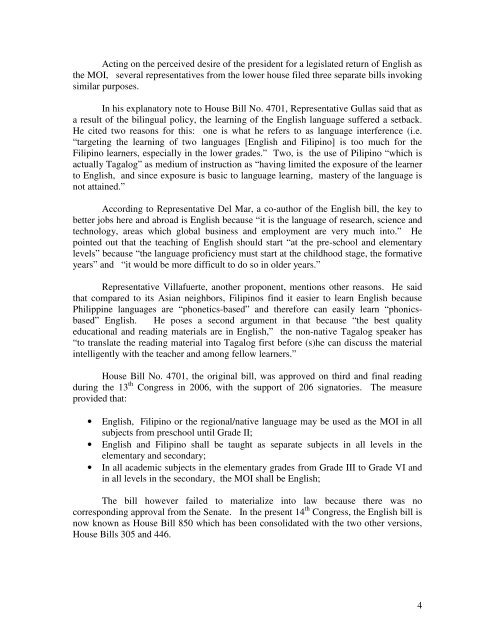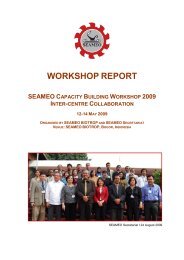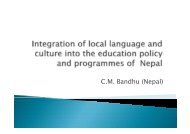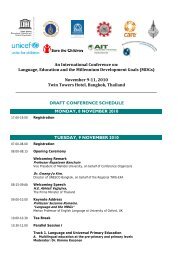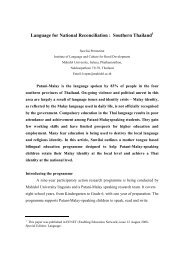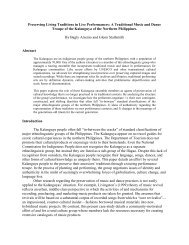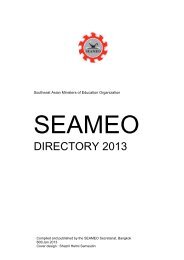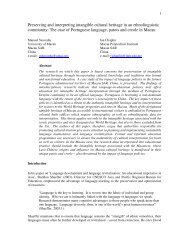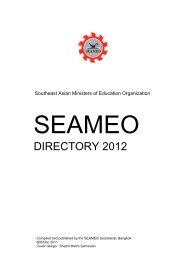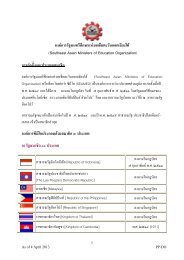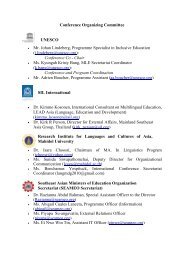THE PROSPECTS OF MULTILINGUAL EDUCATION ... - SEAMEO
THE PROSPECTS OF MULTILINGUAL EDUCATION ... - SEAMEO
THE PROSPECTS OF MULTILINGUAL EDUCATION ... - SEAMEO
Create successful ePaper yourself
Turn your PDF publications into a flip-book with our unique Google optimized e-Paper software.
Acting on the perceived desire of the president for a legislated return of English as<br />
the MOI, several representatives from the lower house filed three separate bills invoking<br />
similar purposes.<br />
In his explanatory note to House Bill No. 4701, Representative Gullas said that as<br />
a result of the bilingual policy, the learning of the English language suffered a setback.<br />
He cited two reasons for this: one is what he refers to as language interference (i.e.<br />
“targeting the learning of two languages [English and Filipino] is too much for the<br />
Filipino learners, especially in the lower grades.” Two, is the use of Pilipino “which is<br />
actually Tagalog” as medium of instruction as “having limited the exposure of the learner<br />
to English, and since exposure is basic to language learning, mastery of the language is<br />
not attained.”<br />
According to Representative Del Mar, a co-author of the English bill, the key to<br />
better jobs here and abroad is English because “it is the language of research, science and<br />
technology, areas which global business and employment are very much into.” He<br />
pointed out that the teaching of English should start “at the pre-school and elementary<br />
levels” because “the language proficiency must start at the childhood stage, the formative<br />
years” and “it would be more difficult to do so in older years.”<br />
Representative Villafuerte, another proponent, mentions other reasons. He said<br />
that compared to its Asian neighbors, Filipinos find it easier to learn English because<br />
Philippine languages are “phonetics-based” and therefore can easily learn “phonicsbased”<br />
English. He poses a second argument in that because “the best quality<br />
educational and reading materials are in English,” the non-native Tagalog speaker has<br />
“to translate the reading material into Tagalog first before (s)he can discuss the material<br />
intelligently with the teacher and among fellow learners.”<br />
House Bill No. 4701, the original bill, was approved on third and final reading<br />
during the 13 th Congress in 2006, with the support of 206 signatories. The measure<br />
provided that:<br />
• English, Filipino or the regional/native language may be used as the MOI in all<br />
subjects from preschool until Grade II;<br />
• English and Filipino shall be taught as separate subjects in all levels in the<br />
elementary and secondary;<br />
• In all academic subjects in the elementary grades from Grade III to Grade VI and<br />
in all levels in the secondary, the MOI shall be English;<br />
The bill however failed to materialize into law because there was no<br />
corresponding approval from the Senate. In the present 14 th Congress, the English bill is<br />
now known as House Bill 850 which has been consolidated with the two other versions,<br />
House Bills 305 and 446.<br />
4


